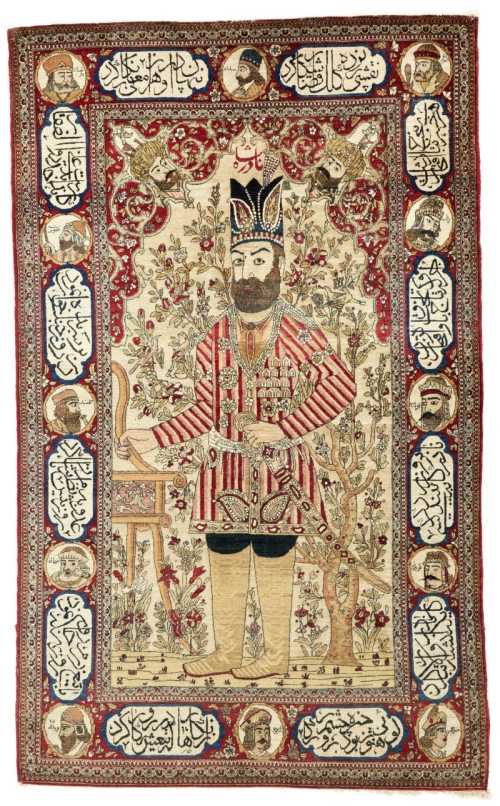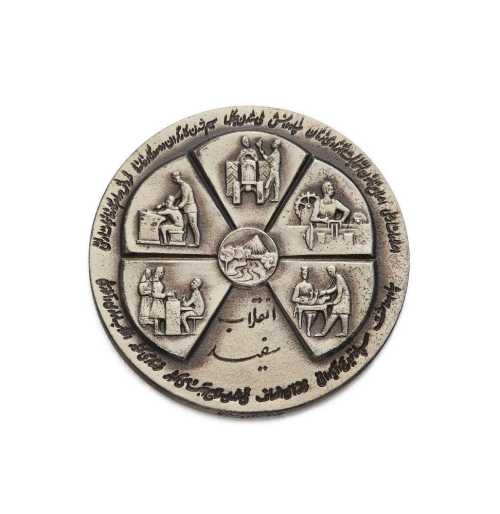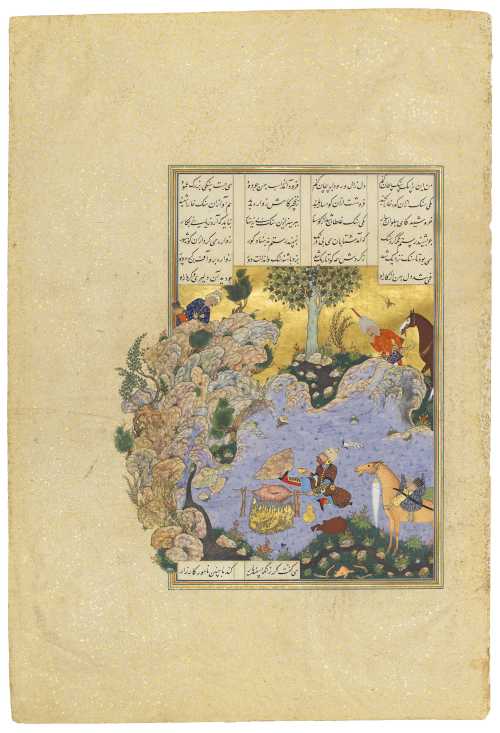- RUSTAM KICKING AWAY THE BOULDER PUSHED BY BAHMAN 1530
- Handicrafts and classics, miniature
- 31.1 * 47.2 cm
- ATTRIBUTED TO AQA MIRAK, ASSISTED BY QASIM BIN 'ALI, SAFAVID TABRIZ, CIRCA 1530
Folio 451 from the Shah Tahmasp Shahnama, gouache heightened with silver and gold on paper, panels of Persian nasta'liq verses in four columns above and below between gold and black rules, in gold and coloured ruled margin, gold-sprinkled leaf, the reverse with 22ll. of nasta'liq arranged in four columns, an illuminated heading panel below, in similar margins
Painting 8 1⁄4 x 8 3⁄8in. (20.8 x 21.2cm.); folio 18 1⁄2 x 12 1⁄4in. (47.2 x 31.1cm.)
Estimation
£2,500,000
3,290,340 USD
-
£4,000,000
5,264,543 USD
Realized Price
£4,842,000
6,372,730 USD
48.985%
Artwork Description
The copy of the Shahnama commissioned by Shah Isma’il and completed under his son Shah Tahmasp, is quite simply one of the most astonishing manuscripts ever made by any culture. Its extraordinary and consistent quality despite its long period of manufacture, and above all its employment of all the leading artists in the kingdom, working in the royal atelier, painting all 258 illustrations to the text, are unparalleled. It remains, by a huge margin, the most ambitious copy of the Iranian national epic, the Shahnama, ever commissioned, let alone completed, and one of the most magnificent of all illustrated manuscripts ever created.
Much has been written about this extraordinary manuscript, discussing it in detail from historical, art historical, ideological, political, technical and many other angles. The great American scholar of Persian and Indian paintings, Stuart Cary Welch concentrated on it for many years, writing a number of publications, including, working with M. B. Dickson, the two-volume magnum opus, The Houghton Shahnama, published in 1981. The story is now well-known and easily accessed, as is the tale of its subsequent history through the presentation to Selim II at his accession on 21 February 1568, its ownership by the Paris Rothschilds, the sale to Arthur Houghton Jnr and its subsequent separation and partial dispersal, culminating in the film noir scene on the Vienna airport tarmac when the binding, text, opening illumination and remaining 118 paintings were exchanged for Willem de Kooning’s Woman III. A list of references at the end of this note will provide all the information on the background to this extraordinary manuscript.
There were three main artists who were in charge of the project over the eighteen years that it lasted. The first two were Sultan Muhammad and Mir Musavvir; the latter part of the manuscript was overseen by Aqa Mirak, who is also the principal artist of the present illustration. His contemporary Dust-Muhammad, rarely short of hyperbole, describes him as “the genius of the age, the prodigy of our era!”. He goes on to claim that “he but picks up his brush and depicts for us pictures of unparalleled delight”. Having taken over this project at some stage in the early to mid-1530s, he was still recorded by the Shah’s brother Sam Mirza in 1550, after the court’s move to Qazvin, as being “the guiding spirit of the corps” [of artists in the royal atelier]. He is recorded in various places as having worked in a large scale in architectural interiors as well as on the intricate scale seen here. In addition to being a court artist, he was a personal companion of the Shah, described by Qazi Ahmad as being “a man wise in his ways” as well as being “congenial in society”.
The analysis of his style is based on the four paintings by him in the British Library Khamseh of Nizami of 1539-43 (Or.2265). As Welch states clearly, there are two groups of paintings which are attributed to this artist, the first of which initially he referred to as “Painter of the Big Figures”, which he describes as youthful and full of energy. What is also apparent on looking at them together is that, apart from the unusually large figures, they display far less horror vacui than most of the other paintings in the manuscript. He is quite happy to have the figures set against relatively simple backgrounds, each in his or her own space, with few other features. It is only in his later paintings in the manuscript, of which there are far fewer, that he develops the full style that is encountered in the British Library Khamseh, and in his final painting for the manuscript, the depiction of Faridun, in the guise of a Dragon, tests his Sons, folio 42 from the original manuscript, at one stage in the collection of Stuart Cary Welch, which sold for a world record price at Sotheby’s 6 April 2011, lot 78, and is now in the Aga Khan Museum, Toronto. As Welch notes, his painting from this period “can captivate with a nuance”.
The painting demonstrates a number of classic visual observations that also appear in other works by the artist. A careful reading shows that the space is divided by the silver stream, almost making the lilac area into an island. The stream starts below a central tree similar to that in at the top of the British Library Nizami scene Shapur informs Khusraw that Shirin awaits (f. 58r.). The way the stream flows in short waterfalls where the silver is heaped and piled to depict the furiously bubbling water can be found in many of his paintings. He uses fewer and smaller flowers than many of his contemporaries, but this allows each brilliant red flowerhead to glow brilliantly in its own space just as the figures are each allowed their space. The single flower in the middle of the rocks is exquisite.
With 258 paintings demanded by the commission for the original manuscript, many are of subjects that are rarely or never depicted elsewhere, for which the artist(s) had a completely ‘blank canvas’ on which to compose their version of the event to be depicted. The present folio, in contrast, depicts one of the perennially favourite subjects for illustration. For example another, earlier Timurid, version of the same scene is included in this sale as lot 58. Aqa Mirak in this version has followed the classic depiction of Rustam, placing him relatively central, following the text and thus giving him a cup full of wine, apparently performing a Cossack dance while roasting his onager, all without spilling a drop. The rock thrown by Bahman appears almost an attribute of the dance, so little does it worry our hero.
The structure of the composition enhances the story, dominated by the diagonal line that connects the right hand side of the green mound in the foreground, passing straight through the central figure of Rustam, picked up by small rocks in the landscape before being continued through the tops of rocks within the mountain leading directly to the perpetrator Bahman. He and Rustam are thus permanently frozen in the moment, looking at each other along this line. Even the baton in Zawara’s turban emphasises the same diagonal line by echoing it to one side.
Much has been written about this extraordinary manuscript, discussing it in detail from historical, art historical, ideological, political, technical and many other angles. The great American scholar of Persian and Indian paintings, Stuart Cary Welch concentrated on it for many years, writing a number of publications, including, working with M. B. Dickson, the two-volume magnum opus, The Houghton Shahnama, published in 1981. The story is now well-known and easily accessed, as is the tale of its subsequent history through the presentation to Selim II at his accession on 21 February 1568, its ownership by the Paris Rothschilds, the sale to Arthur Houghton Jnr and its subsequent separation and partial dispersal, culminating in the film noir scene on the Vienna airport tarmac when the binding, text, opening illumination and remaining 118 paintings were exchanged for Willem de Kooning’s Woman III. A list of references at the end of this note will provide all the information on the background to this extraordinary manuscript.
There were three main artists who were in charge of the project over the eighteen years that it lasted. The first two were Sultan Muhammad and Mir Musavvir; the latter part of the manuscript was overseen by Aqa Mirak, who is also the principal artist of the present illustration. His contemporary Dust-Muhammad, rarely short of hyperbole, describes him as “the genius of the age, the prodigy of our era!”. He goes on to claim that “he but picks up his brush and depicts for us pictures of unparalleled delight”. Having taken over this project at some stage in the early to mid-1530s, he was still recorded by the Shah’s brother Sam Mirza in 1550, after the court’s move to Qazvin, as being “the guiding spirit of the corps” [of artists in the royal atelier]. He is recorded in various places as having worked in a large scale in architectural interiors as well as on the intricate scale seen here. In addition to being a court artist, he was a personal companion of the Shah, described by Qazi Ahmad as being “a man wise in his ways” as well as being “congenial in society”.
The analysis of his style is based on the four paintings by him in the British Library Khamseh of Nizami of 1539-43 (Or.2265). As Welch states clearly, there are two groups of paintings which are attributed to this artist, the first of which initially he referred to as “Painter of the Big Figures”, which he describes as youthful and full of energy. What is also apparent on looking at them together is that, apart from the unusually large figures, they display far less horror vacui than most of the other paintings in the manuscript. He is quite happy to have the figures set against relatively simple backgrounds, each in his or her own space, with few other features. It is only in his later paintings in the manuscript, of which there are far fewer, that he develops the full style that is encountered in the British Library Khamseh, and in his final painting for the manuscript, the depiction of Faridun, in the guise of a Dragon, tests his Sons, folio 42 from the original manuscript, at one stage in the collection of Stuart Cary Welch, which sold for a world record price at Sotheby’s 6 April 2011, lot 78, and is now in the Aga Khan Museum, Toronto. As Welch notes, his painting from this period “can captivate with a nuance”.
The painting demonstrates a number of classic visual observations that also appear in other works by the artist. A careful reading shows that the space is divided by the silver stream, almost making the lilac area into an island. The stream starts below a central tree similar to that in at the top of the British Library Nizami scene Shapur informs Khusraw that Shirin awaits (f. 58r.). The way the stream flows in short waterfalls where the silver is heaped and piled to depict the furiously bubbling water can be found in many of his paintings. He uses fewer and smaller flowers than many of his contemporaries, but this allows each brilliant red flowerhead to glow brilliantly in its own space just as the figures are each allowed their space. The single flower in the middle of the rocks is exquisite.
With 258 paintings demanded by the commission for the original manuscript, many are of subjects that are rarely or never depicted elsewhere, for which the artist(s) had a completely ‘blank canvas’ on which to compose their version of the event to be depicted. The present folio, in contrast, depicts one of the perennially favourite subjects for illustration. For example another, earlier Timurid, version of the same scene is included in this sale as lot 58. Aqa Mirak in this version has followed the classic depiction of Rustam, placing him relatively central, following the text and thus giving him a cup full of wine, apparently performing a Cossack dance while roasting his onager, all without spilling a drop. The rock thrown by Bahman appears almost an attribute of the dance, so little does it worry our hero.
The structure of the composition enhances the story, dominated by the diagonal line that connects the right hand side of the green mound in the foreground, passing straight through the central figure of Rustam, picked up by small rocks in the landscape before being continued through the tops of rocks within the mountain leading directly to the perpetrator Bahman. He and Rustam are thus permanently frozen in the moment, looking at each other along this line. Even the baton in Zawara’s turban emphasises the same diagonal line by echoing it to one side.
More lots by Unknown Artist

An Isfahan pictorial rug, Central Persia, circa 1910
Estimation
£4,000
5,236 USD
-
£6,000
7,853 USD
Realized Price
£5,670
7,421 USD
13.4%
Sale Date
Sotheby's
-
30 March 2022

A gold medal commemorating the coronation of Muhammad Reza Shah and Queen Farah
Estimation
£100
132 USD
-
£200
263 USD
Realized Price
£160
211 USD
6.667%
Sell at
Sale Date
Rosebery's Auction
-
1 April 2022

A silver memorial medal of the White Revolution, Muhammad Reza Shah, 1967
Estimation
£200
263 USD
-
£300
395 USD
Realized Price
£170
224 USD
32%
Sell at
Sale Date
Rosebery's Auction
-
1 April 2022
Realized Price
67,245 USD
Min Estimate
35,481 USD
Max Estimate
53,247 USD
Average Artwork Worth
+83.63%
Average Growth of Artwork Worth
Sales Performance Against Estimates
Average & Median Sold Lot Value
2021 - 2025
Performance vs. Estimate
2021 - 2025
Sell-through Rate
2021 - 2025



